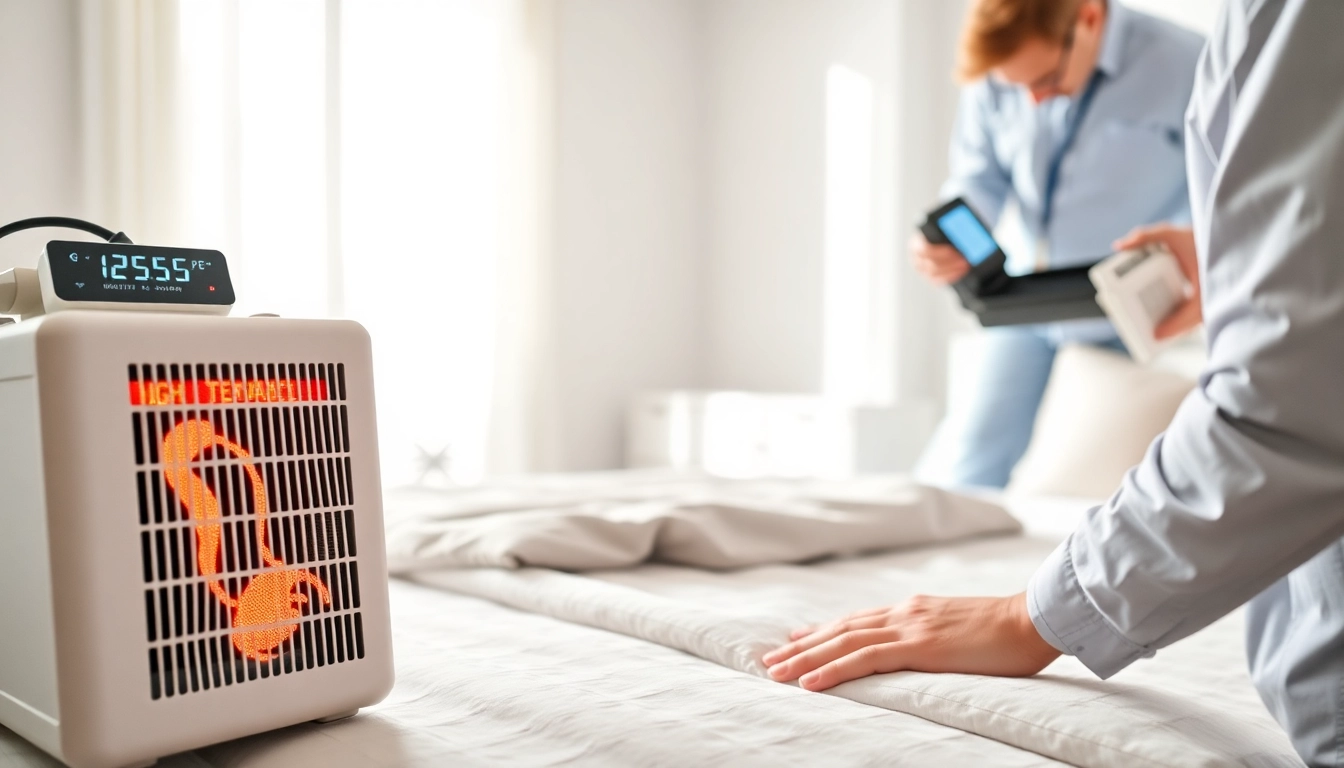Understanding Bed Bug Heat Treatment
What is Bed Bug Heat Treatment?
Bed bug heat treatment is a pest control method that utilizes elevated temperatures to exterminate bed bugs in all life stages, from eggs to adults. This approach leverages heat as a biological pesticide, killing these resilient pests swiftly and effectively without the need for chemical insecticides. Ideally, the ambient temperature needs to reach a consistent 120°F to 140°F (49°C to 60°C) for a duration sufficient to ensure that bed bugs are completely eradicated. Professional exterminators implement specialized equipment and techniques to achieve and maintain these temperatures throughout a targeted area, ensuring comprehensive coverage.
How Does Heat Kill Bed Bugs?
Heat kills bed bugs through a process that essentially attacks their vital biological functions. When bed bugs are exposed to high temperatures, their body proteins denature, leading to cellular breakdown and death. Research indicates that bed bugs must be exposed to temperatures of at least 120°F for a minimum of 90 minutes to ensure complete mortality. Higher temperatures can decrease exposure time; for example, temperatures reaching 130°F can be fatal in as little as 30 minutes. Heat treatment works effectively because it penetrates deep into bedding, furniture, and other hiding spots where these pests reside. Thus, heat treatment is not merely surface-level; it targets the entire infestation.
Advantages of Heat Over Chemical Treatments
Choosing Bed bug heat treatment over chemical pesticides comes with numerous advantages:
- Environmentally Friendly: Heat treatment eliminates the need for chemical insecticides, making it a safer option for families and pets.
- Effectiveness: Heat can kill bed bugs at all life stages, including eggs, which many chemical treatments fail to penetrate.
- Speed: Treatments can often be completed within hours rather than days or weeks, allowing for minimal disruption of daily life.
- Less Mess: Unlike chemical treatments that may require extensive cleaning, heat treatments typically maintain a cleaner environment.
- One-Time Treatment: In many cases, heat treatment may eliminate the need for multiple treatment sessions common with chemical pesticides.
Preparing for Bed Bug Heat Treatment
How to Prepare Your Home?
Preparation is crucial for the success of a bed bug heat treatment. Homeowners should follow these steps:
- Clear the Area: Move all belongings, especially those that are heat-sensitive, away from the area where treatment will be applied. This includes plants, pets, food, and any items that could be damaged by high temperatures.
- Declutter: Reduce clutter in the infested areas as much as possible. This makes it easier for heat to circulate and penetrate to the bed bugs.
- Prepare Bedding and Fabrics: Wash all bedding, clothing, and upholstery in hot water and dry on high heat to reduce the overall bed bug load.
Precautions to Take During Treatment
Safety during the treatment process is paramount. Consider the following precautions:
- Ensure that all individuals, including pets, leave the premises during the treatment.
- Notify your pest control service provider about any specific concerns or items that may require special attention.
- Check for any combustible materials in the area that should be removed prior to commencement.
Common Mistakes to Avoid Before Treatment
To maximize the efficacy of the Bed bug heat treatment, avoid these common pitfalls:
- Ignoring Instructions: Always follow the detailed instructions provided by your pest control expert for preparation.
- Leaving Items Behind: Failing to clear all personal items from the treatment area can hinder the treatment’s effectiveness.
- Neglecting Heat-Sensitive Items: Not removing or properly protecting items that could be damaged by extreme temperatures can result in loss of valuables.
The Bed Bug Heat Treatment Process
Step-by-Step of a Typical Treatment
The bed bug heat treatment process typically unfolds in the following steps:
- Preparation and Setup: The exterminator will arrive to evaluate the area, set up heaters, and monitor equipment for safety and effectiveness.
- Heating: Heaters are turned on to gradually raise the temperature of the affected area to the target range of 120°F to 140°F.
- Monitoring: Temperature sensors are placed strategically throughout the premises to ensure optimal heat distribution and monitoring of the entire treatment area.
- Duration: The area is maintained at the specified temperature for a minimum of several hours, usually around four to six, to ensure all bed bugs are killed.
- Cooling Down: After the treatment duration, the heaters are turned off, and the area is allowed to cool back to a safe temperature.
What to Expect During the Treatment
During the heat treatment, homeowners can expect the following:
- The treated area should remain unoccupied for several hours.
- Specialized heaters will generate noise, but this is typical during treatment.
- The technician will regularly check temperature readings to maintain optimal conditions.
Duration and Effectiveness of Treatment
Generally, the entire bed bug heat treatment process can last from around six to eight hours, including setup and cooling time. The effectiveness is highly rated, with many treatments resulting in complete eradication on the first attempt, provided that proper procedures are followed before, during, and after the treatment.
Post-Treatment Care and Follow-Up
What to Do After the Treatment?
After the bed bug heat treatment, homeowners should adhere to specific post-treatment care:
- Wait Period: Generally, it’s advised to wait for a minimum of 24 hours before returning to the treated area to ensure that everything has safely cooled down.
- Inspect: Conduct a thorough inspection of the area to check for any signs of remaining activity.
- Monitor: Keep an eye out for any new bed bug activity for a few weeks post-treatment.
Signs That Treatment Was Effective
Significant indicators of a successful bed bug heat treatment include:
- No sightings of live bed bugs.
- No new bites reported, indicating that the population has been effectively reduced.
- Dead bed bugs or eggs found during inspections.
When to Schedule a Follow-Up Inspection
It is generally advisable to schedule a follow-up inspection approximately 4 to 6 weeks after the initial treatment. This will help ensure that any remaining bugs that may have been missed during the initial heat treatment can be addressed immediately.
Cost Factors for Bed Bug Heat Treatment
Average Costs Involved in Treatments
The cost of bed bug heat treatment can vary widely based on several factors, including the size of the area being treated and the severity of the infestation. On average, homeowners can expect to pay anywhere from $1,000 to $2,500 for comprehensive treatment. This price often includes equipment, labor, and follow-up inspections.
Factors That Influence Pricing
Several factors can impact the overall cost of bed bug heat treatment:
- Infestation Level: More extensive infestations will require additional time and resources, raising the total cost.
- Property Size: Larger properties typically incur higher costs due to increased heating requirements.
- Local Market Rates: Prices can also vary based on geographic location and the general market for pest control services in that area.
Evaluating the Value of Professional Services
Investing in professional bed bug heat treatment services is often a worthwhile expense for peace of mind and effective pest control. While the costs may appear substantial, the long-term benefits of achieving a bed bug-free environment can outweigh the initial financial investment. Factors to evaluate include:
- The expertise and experience of the pest control service provider.
- Customer reviews and testimonials regarding effectiveness and customer satisfaction.
- Inclusion of guarantees or warranties on treatments performed.



